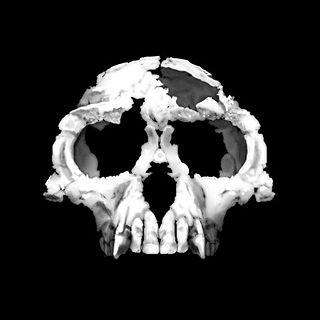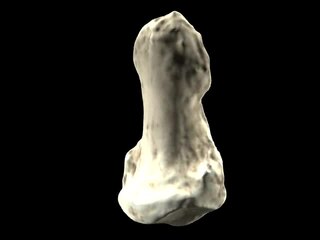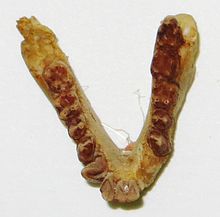
Ardipithecus is a genus of an extinct hominine that lived during the Late Miocene and Early Pliocene epochs in the Afar Depression, Ethiopia. Originally described as one of the earliest ancestors of humans after they diverged from the chimpanzees, the relation of this genus to human ancestors and whether it is a hominin is now a matter of debate. Two fossil species are described in the literature: A. ramidus, which lived about 4.4 million years ago during the early Pliocene, and A. kadabba, dated to approximately 5.6 million years ago. Initial behavioral analysis indicated that Ardipithecus could be very similar to chimpanzees, however more recent analysis based on canine size and lack of canine sexual dimorphism indicates that Ardipithecus was characterised by reduced aggression, and that they more closely resemble bonobos.

Orrorin is an extinct genus of primate within Homininae from the Miocene Lukeino Formation and Pliocene Mabaget Formation, both of Kenya.

Dentition pertains to the development of teeth and their arrangement in the mouth. In particular, it is the characteristic arrangement, kind, and number of teeth in a given species at a given age. That is, the number, type, and morpho-physiology of the teeth of an animal.

A saber-tooth is any member of various extinct groups of predatory therapsids, predominantly carnivoran mammals, that are characterized by long, curved saber-shaped canine teeth which protruded from the mouth when closed. Saber-toothed mammals have been found almost worldwide from the Eocene epoch to the end of the Pleistocene epoch.

Machairodontinae is an extinct subfamily of carnivoran mammals of the family Felidae. They were found in Asia, Africa, North America, South America, and Europe, with the earliest species known from the Middle Miocene, with the last surviving species becoming extinct around Late Pleistocene-Holocene transition.

Aegyptopithecus is an early fossil catarrhine that predates the divergence between hominoids (apes) and cercopithecids. It is known from a single species, Aegyptopithecus zeuxis, which lived around 38-29.5 million years ago in the early part of the Oligocene epoch. It likely resembled modern-day New World monkeys, and was about the same size as a modern howler monkey, which is about 56 to 92 cm long. Aegyptopithecus fossils have been found in the Jebel Qatrani Formation of modern-day Egypt. Aegyptopithecus is believed to be a stem-catarrhine, a crucial link between Eocene and Miocene fossils.

Placodus is an extinct genus of marine reptiles belonging to the order Placodontia, which swam in the shallow seas of the middle Triassic period. Fossils of Placodus have been found in Central Europe and China.

Afropithecus is a genus of Miocene hominoid with the sole species Afropithecus turkanensis, it was excavated from a small site near Lake Turkana called Kalodirr in northern Kenya in 1986 and named by Richard Leakey and Meave Leakey. The estimated age of Afropithecus is between 16 and 18 million years old, which was determined with radiometric dating techniques and the geological studies conducted by Broschetto and Brown from the University of Utah. In total there are 46 recovered specimens from Kalodirr relating to Afropithecus consisting of cranial, mandible, dentition and post-cranial remains. The type specimen of Afropithecus turkanensis is KNM-WK 16999.

Thylacosmilus is an extinct genus of saber-toothed metatherian mammals that inhabited South America from the Late Miocene to Pliocene epochs. Though Thylacosmilus looks similar to the "saber-toothed cats", it was not a felid, like the well-known North American Smilodon, but a sparassodont, a group closely related to marsupials, and only superficially resembled other saber-toothed mammals due to convergent evolution. A 2005 study found that the bite forces of Thylacosmilus and Smilodon were low, which indicates the killing-techniques of saber-toothed animals differed from those of extant species. Remains of Thylacosmilus have been found primarily in Catamarca, Entre Ríos, and La Pampa Provinces in northern Argentina.

Thrinaxodon is an extinct genus of cynodonts, including the species T. liorhinus which lived in what are now South Africa and Antarctica during the Early Triassic. Thrinaxodon lived just after the Permian–Triassic mass extinction event, its survival during the extinction may have been due to its burrowing habits.

Gorgonopsia is an extinct clade of sabre-toothed therapsids from the Middle to the Upper Permian, roughly between 265 and 252 million years ago. They are characterised by a long and narrow skull, as well as elongated upper and sometimes lower canine teeth and incisors which were likely used as slashing and stabbing weapons. Postcanine teeth are generally reduced or absent. For hunting large prey, they possibly used a bite-and-retreat tactic, ambushing and taking a debilitating bite out of the target, and following it at a safe distance before its injuries exhausted it, whereupon the gorgonopsian would grapple the animal and deliver a killing bite. They would have had an exorbitant gape, possibly in excess of 90°, without having to unhinge the jaw.
Mosaic evolution is the concept, mainly from palaeontology, that evolutionary change takes place in some body parts or systems without simultaneous changes in other parts. Another definition is the "evolution of characters at various rates both within and between species".408 Its place in evolutionary theory comes under long-term trends or macroevolution.

Cladosictis is an extinct genus of South American metatherian from Patagonia, Argentina and Chile.

Imagotaria is an extinct monotypic genus of walrus with the sole species Imagotaria downsi. Fossils of Imagotaria are known from the early late Miocene of California.

Syndyoceras is a small extinct genus of Artiodactyla, of the family Protoceratidae, endemic to central North America from the Miocene epoch, existing for approximately 4.2 million years.

Progalesaurus is an extinct genus of galesaurid cynodont from the early Triassic. Progalesaurus is known from a single fossil of the species Progalesaurus lootsbergensis, found in the Lystrosaurus Assemblage Zone of the Balfour Formation. Close relatives of Progalesaurus, other galesaurids, include Galesaurus and Cynosaurus. Galesaurids appeared just before the Permian-Triassic extinction event, and disappeared from the fossil record in the Middle-Triassic.

A tooth is a hard, calcified structure found in the jaws of many vertebrates and used to break down food. Some animals, particularly carnivores and omnivores, also use teeth to help with capturing or wounding prey, tearing food, for defensive purposes, to intimidate other animals often including their own, or to carry prey or their young. The roots of teeth are covered by gums. Teeth are not made of bone, but rather of multiple tissues of varying density and hardness that originate from the outermost embryonic germ layer, the ectoderm.

Saadanius is a genus of fossil primates dating to the Oligocene that is closely related to the common ancestor of the Old World monkeys and apes, collectively known as catarrhines. It is represented by a single species, Saadanius hijazensis, which is known only from a single partial skull tentatively dated between 29 and 28 million years ago. It was discovered in 2009 in western Saudi Arabia near Mecca and was first described in 2010 after comparison with both living and fossil catarrhines.

Tiarajudens is an extinct genus of saber-toothed herbivorous anomodonts which lived during the Middle Permian period in what is now Rio Grande do Sul, Brazil. It is known from the holotype UFRGS PV393P, a nearly complete skull. The type species T. eccentricus was named in 2011.
Propliopithecoidea is a superfamily of catarrhine primates that inhabited Africa and the Arabian Peninsula during the Early Oligocene about 32 to 29 million years ago. Fossils have been found in Egypt, Oman and Angola. They are one of the earliest known families of catarrhines. They have a number of features in common with extant catarrhines, but also features that are primitive and not found in later catarrhine families.






















